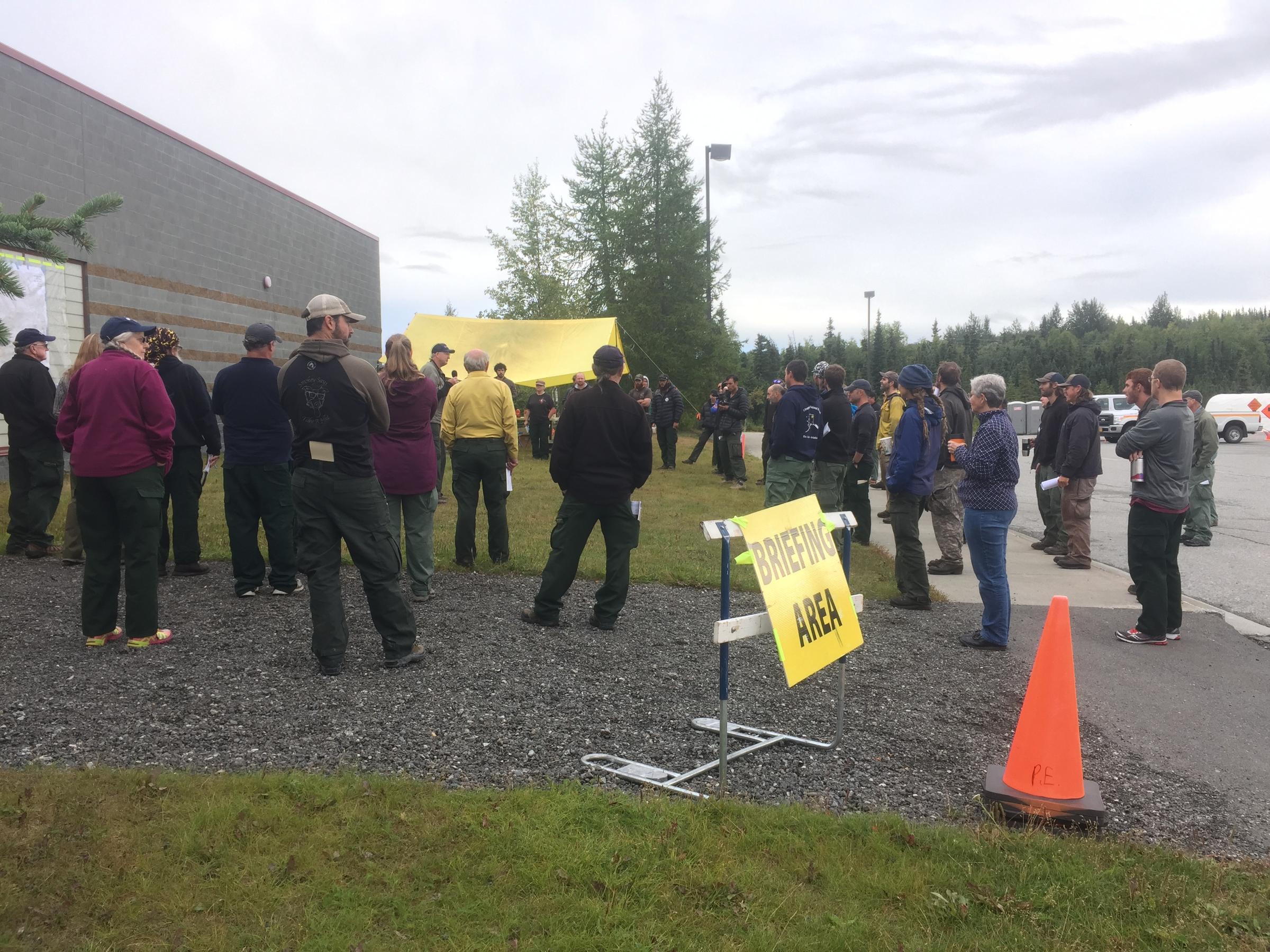Experienced firefighters can earn up to 60-thousand dollars in a few months, which may seem like a lot of money. But considering their working conditions, and hazards, many of them would say they earn every bit of their pay. A few dozen Alaskan firefighters are mopping up the McHugh fire south of Anchorage.

(Photo by Joaqlin Estus, KNBA – Anchorage)
Everyone working a fire – from incident commanders to accountants – sleeps in tents. Firefighters sometimes camp just a short hike from the fire. And at most camps, everyone eats military style field rations known as MREs – or meals ready to eat — three times a day.
Firefighters go to the fire carrying all the food, water, and safety gear — including an emergency shelter — needed for that shift, which typically will be 12 hours long but can run to 20 hours. To qualify for the job, they have to show they can carry a 45-pound pack for 3 miles in less than 45 minutes.
Firefighter James Ludecker, of Fairbanks, is a member of the Tanana Chiefs Conference fire crew. He said months before the fire season he and other crew members start working out a minimum of three hours a day.
“Sometimes we like to go for a hike for at least 45 minutes, just like at a 45-degree angle,” Ludecker said. “Or we like to go for like an 8-mile run, because we like to switch up the body, what we’re doing. We’re not going focus on just the biceps and the chest. We’re going to work the back. We’re going to work the legs. But the main thing I like to get the guys to do is to work the lungs.”
Ludecker said jogging up 45-degree slopes paid off at the McHugh fire.
“Thank God we did do the hills,” Ludecker said. “The fire we’re on now, it’s a good 45-minute hike straight up.”
On scene, crews work to create a fireline, a strip of land maybe 30 feet wide with no fuel for a fire. They remove standing and fallen trees, brush, grass, even tree roots. They remove or bury embers and mix the soil until it’s cool to the touch.
“It’s not a sprint. It’s a marathon,” Kale Casey said. Casey has fought fires for several years himself. This season he’s a public information officer for the Alaska Interagency Management Team. He said he got his start in firefighting as a medic where he saw many injuries related to overuse, as well as everything from blisters to bronchitis and pneumonia. Casey said the job is demanding, but firefighters are passionate about saving lives and property, and become part of a strong fellowship.
“It challenges you on all levels. You’re away from home. You’re away from your loved ones and family, missing weddings, birthdays, music festivals, all the cool stuff other people are doing, the boat trips, canoe, kayak, fishing,” Casey said. “You’re out sucking smoke with other people who love their job, so it creates a tight family.”
Safety is top priority. Firefighters practice what they’ll do if a fire overtakes them. They go over recent accidents, and review the conditions that led to decades-old fatalities. Casey said many firefighters also contribute to the Wildland Firefighters Foundation, which supports firefighters and their families in the event of serious injury or death.
Statistically, most fatalities occur between two and five p.m., when fuels are at their driest and fires are apt to pick up and roar. So, Casey said, firefighters “Take five at two” – a five minute break at two o’clock every day to think about safety.
“Things get extreme,” Casey said. “We stop to get our heads straight and say ‘do we have a safety zone? Do we have an escape route?,Do we have lookouts? Are we in communications? Are we engaged for the right reasons?.What are we trying to achieve? We’re learning how to step back as a culture and ask ‘Is it time to let this fire burn for a bit? This is when people die.'”
Delbert Frank, of Minto and a member of the White Mountain fire crew, said sheer determination is needed to stay in the game.
“It’s a mental thing,” Frank said. “If you see yourself at a wall where it’s going to stop you from doing your work, you’ve gotta break through it.”
The Chena fire crew is also working the McHugh fire, which has been contained. Protective equipment placed in nearby housing subdivisions has been removed. A 35-mile per hour speed limit remains in effect between miles 110 to 112 of the Seward Highway where there is still falling debris. And pullouts outside that stretch of the road have been reopened.
Fire responders will host an Open House at Goldenview Middle School Wednesday, July 27, at 6 p.m. where you can meet responders and get the latest information about the fire.
Joaqlin Estus is a reporter at KNBA in Anchorage.




